Comprehensive Report: Business Operations, Functions, and Performance
VerifiedAdded on 2023/06/06
|11
|3340
|464
Report
AI Summary
This report provides a comprehensive overview of business operations, encompassing accounting, human resources, and team development. It begins with an introduction to business principles, followed by an analysis of key business functions, including the importance of accounting, HR department roles, and the impact of employment legislation in the UK. The report includes an accounting workshop with an income statement and interpretation of profit and loss information. Furthermore, it examines team development stages, motivational theories like Hertzberg's and Maslow's, and various leadership styles. The report concludes with a summary of the findings and provides references to support the analysis, offering valuable insights into effective business strategies and practices.
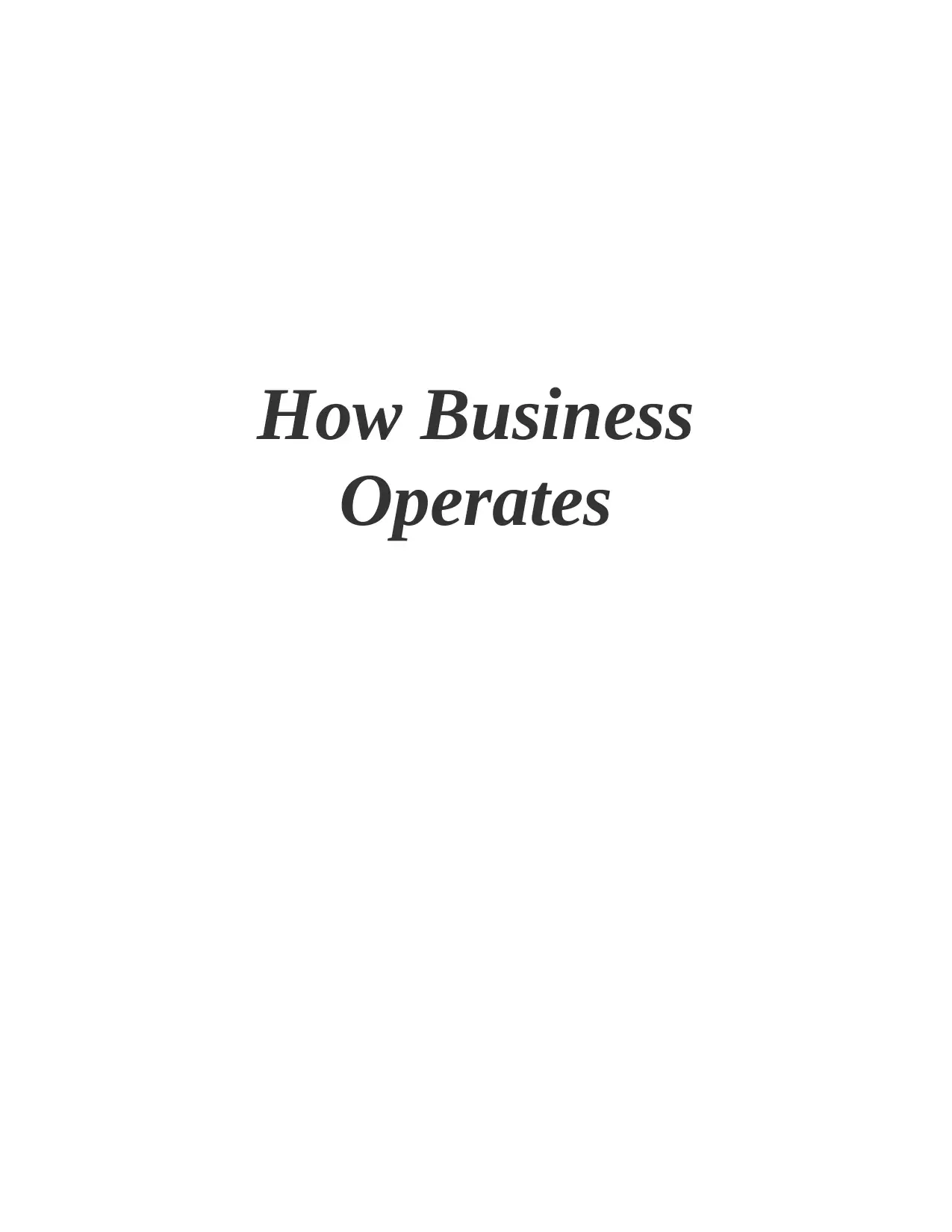
How Business
Operates
Operates
Paraphrase This Document
Need a fresh take? Get an instant paraphrase of this document with our AI Paraphraser
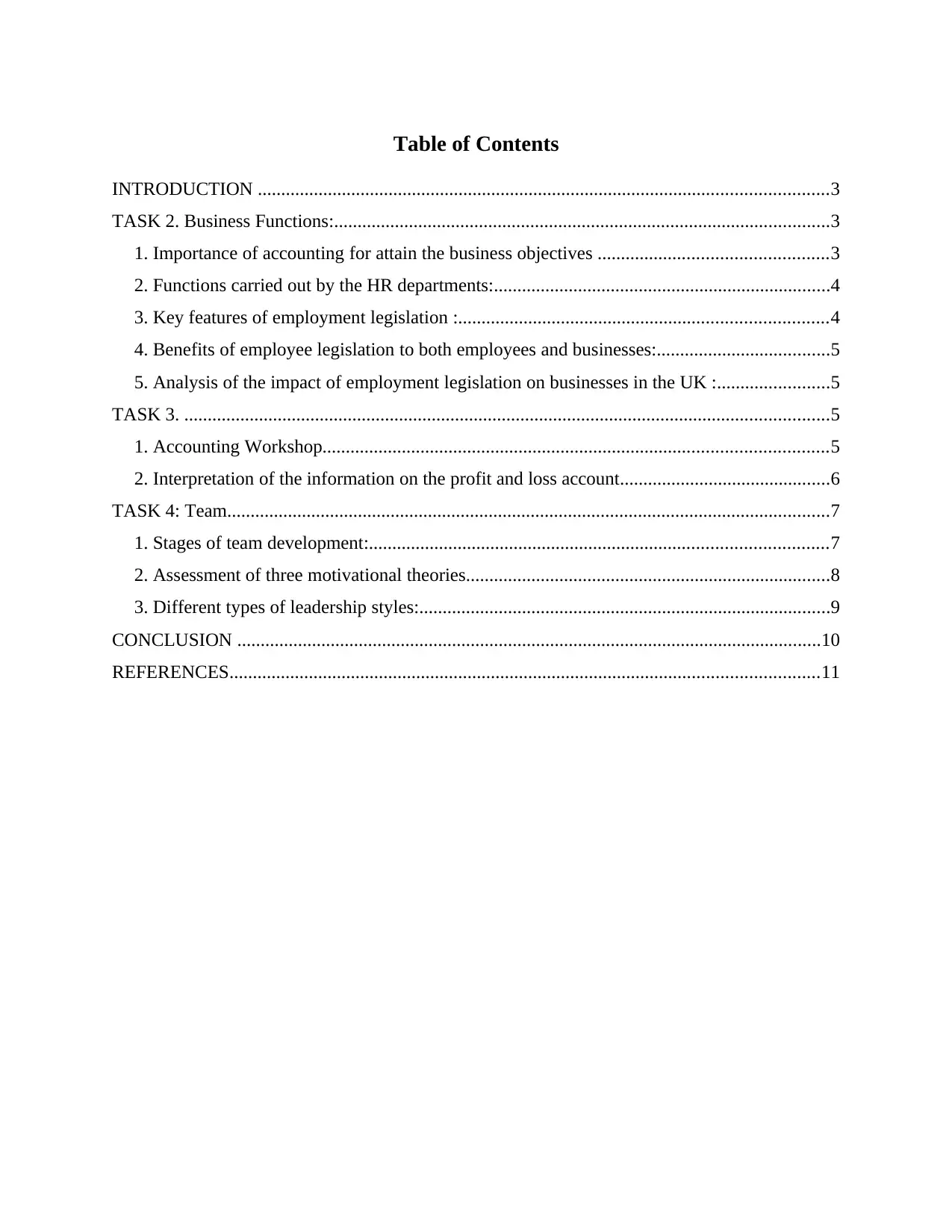
Table of Contents
INTRODUCTION ..........................................................................................................................3
TASK 2. Business Functions:..........................................................................................................3
1. Importance of accounting for attain the business objectives .................................................3
2. Functions carried out by the HR departments:........................................................................4
3. Key features of employment legislation :...............................................................................4
4. Benefits of employee legislation to both employees and businesses:.....................................5
5. Analysis of the impact of employment legislation on businesses in the UK :........................5
TASK 3. ..........................................................................................................................................5
1. Accounting Workshop............................................................................................................5
2. Interpretation of the information on the profit and loss account.............................................6
TASK 4: Team.................................................................................................................................7
1. Stages of team development:..................................................................................................7
2. Assessment of three motivational theories..............................................................................8
3. Different types of leadership styles:........................................................................................9
CONCLUSION .............................................................................................................................10
REFERENCES..............................................................................................................................11
INTRODUCTION ..........................................................................................................................3
TASK 2. Business Functions:..........................................................................................................3
1. Importance of accounting for attain the business objectives .................................................3
2. Functions carried out by the HR departments:........................................................................4
3. Key features of employment legislation :...............................................................................4
4. Benefits of employee legislation to both employees and businesses:.....................................5
5. Analysis of the impact of employment legislation on businesses in the UK :........................5
TASK 3. ..........................................................................................................................................5
1. Accounting Workshop............................................................................................................5
2. Interpretation of the information on the profit and loss account.............................................6
TASK 4: Team.................................................................................................................................7
1. Stages of team development:..................................................................................................7
2. Assessment of three motivational theories..............................................................................8
3. Different types of leadership styles:........................................................................................9
CONCLUSION .............................................................................................................................10
REFERENCES..............................................................................................................................11
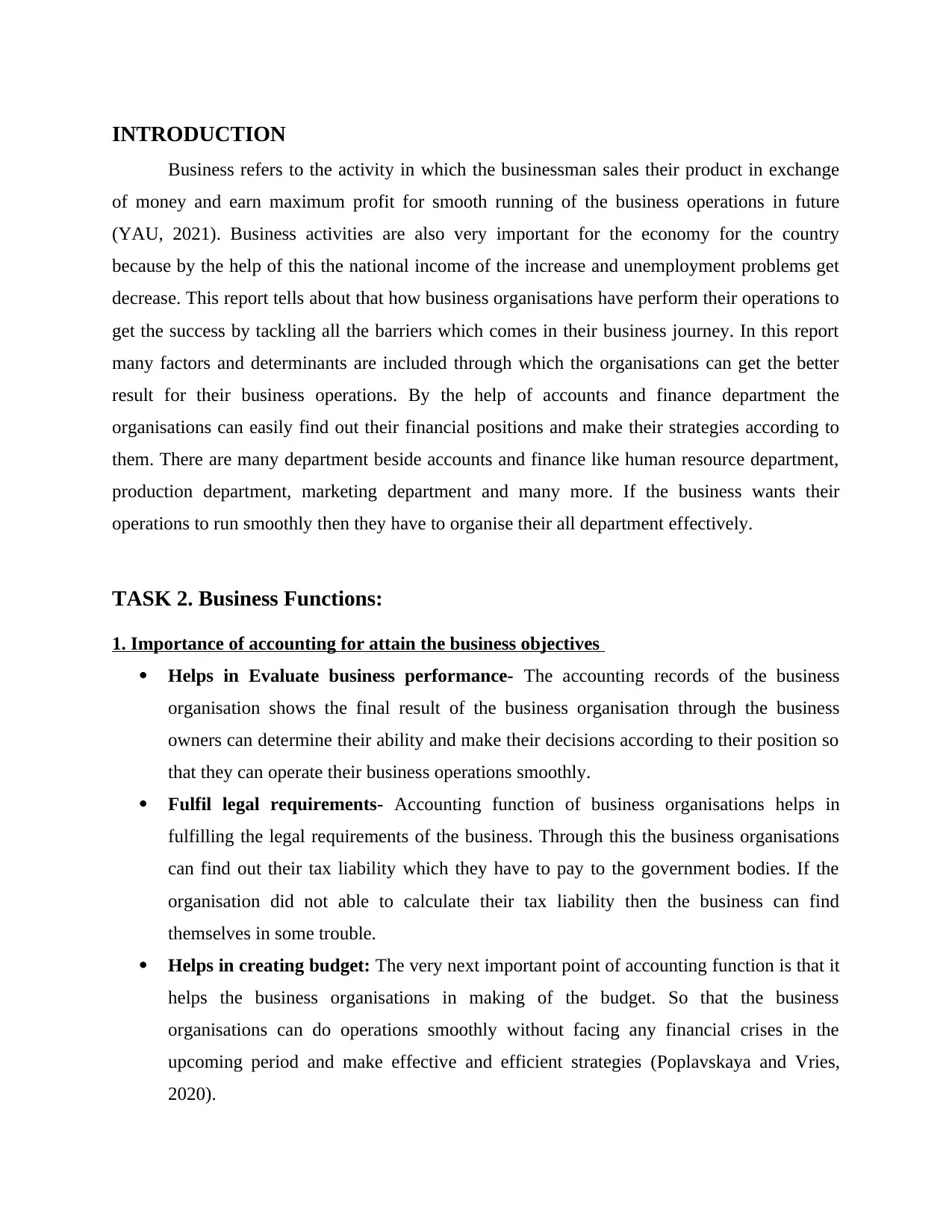
INTRODUCTION
Business refers to the activity in which the businessman sales their product in exchange
of money and earn maximum profit for smooth running of the business operations in future
(YAU, 2021). Business activities are also very important for the economy for the country
because by the help of this the national income of the increase and unemployment problems get
decrease. This report tells about that how business organisations have perform their operations to
get the success by tackling all the barriers which comes in their business journey. In this report
many factors and determinants are included through which the organisations can get the better
result for their business operations. By the help of accounts and finance department the
organisations can easily find out their financial positions and make their strategies according to
them. There are many department beside accounts and finance like human resource department,
production department, marketing department and many more. If the business wants their
operations to run smoothly then they have to organise their all department effectively.
TASK 2. Business Functions:
1. Importance of accounting for attain the business objectives
Helps in Evaluate business performance- The accounting records of the business
organisation shows the final result of the business organisation through the business
owners can determine their ability and make their decisions according to their position so
that they can operate their business operations smoothly.
Fulfil legal requirements- Accounting function of business organisations helps in
fulfilling the legal requirements of the business. Through this the business organisations
can find out their tax liability which they have to pay to the government bodies. If the
organisation did not able to calculate their tax liability then the business can find
themselves in some trouble.
Helps in creating budget: The very next important point of accounting function is that it
helps the business organisations in making of the budget. So that the business
organisations can do operations smoothly without facing any financial crises in the
upcoming period and make effective and efficient strategies (Poplavskaya and Vries,
2020).
Business refers to the activity in which the businessman sales their product in exchange
of money and earn maximum profit for smooth running of the business operations in future
(YAU, 2021). Business activities are also very important for the economy for the country
because by the help of this the national income of the increase and unemployment problems get
decrease. This report tells about that how business organisations have perform their operations to
get the success by tackling all the barriers which comes in their business journey. In this report
many factors and determinants are included through which the organisations can get the better
result for their business operations. By the help of accounts and finance department the
organisations can easily find out their financial positions and make their strategies according to
them. There are many department beside accounts and finance like human resource department,
production department, marketing department and many more. If the business wants their
operations to run smoothly then they have to organise their all department effectively.
TASK 2. Business Functions:
1. Importance of accounting for attain the business objectives
Helps in Evaluate business performance- The accounting records of the business
organisation shows the final result of the business organisation through the business
owners can determine their ability and make their decisions according to their position so
that they can operate their business operations smoothly.
Fulfil legal requirements- Accounting function of business organisations helps in
fulfilling the legal requirements of the business. Through this the business organisations
can find out their tax liability which they have to pay to the government bodies. If the
organisation did not able to calculate their tax liability then the business can find
themselves in some trouble.
Helps in creating budget: The very next important point of accounting function is that it
helps the business organisations in making of the budget. So that the business
organisations can do operations smoothly without facing any financial crises in the
upcoming period and make effective and efficient strategies (Poplavskaya and Vries,
2020).
⊘ This is a preview!⊘
Do you want full access?
Subscribe today to unlock all pages.

Trusted by 1+ million students worldwide
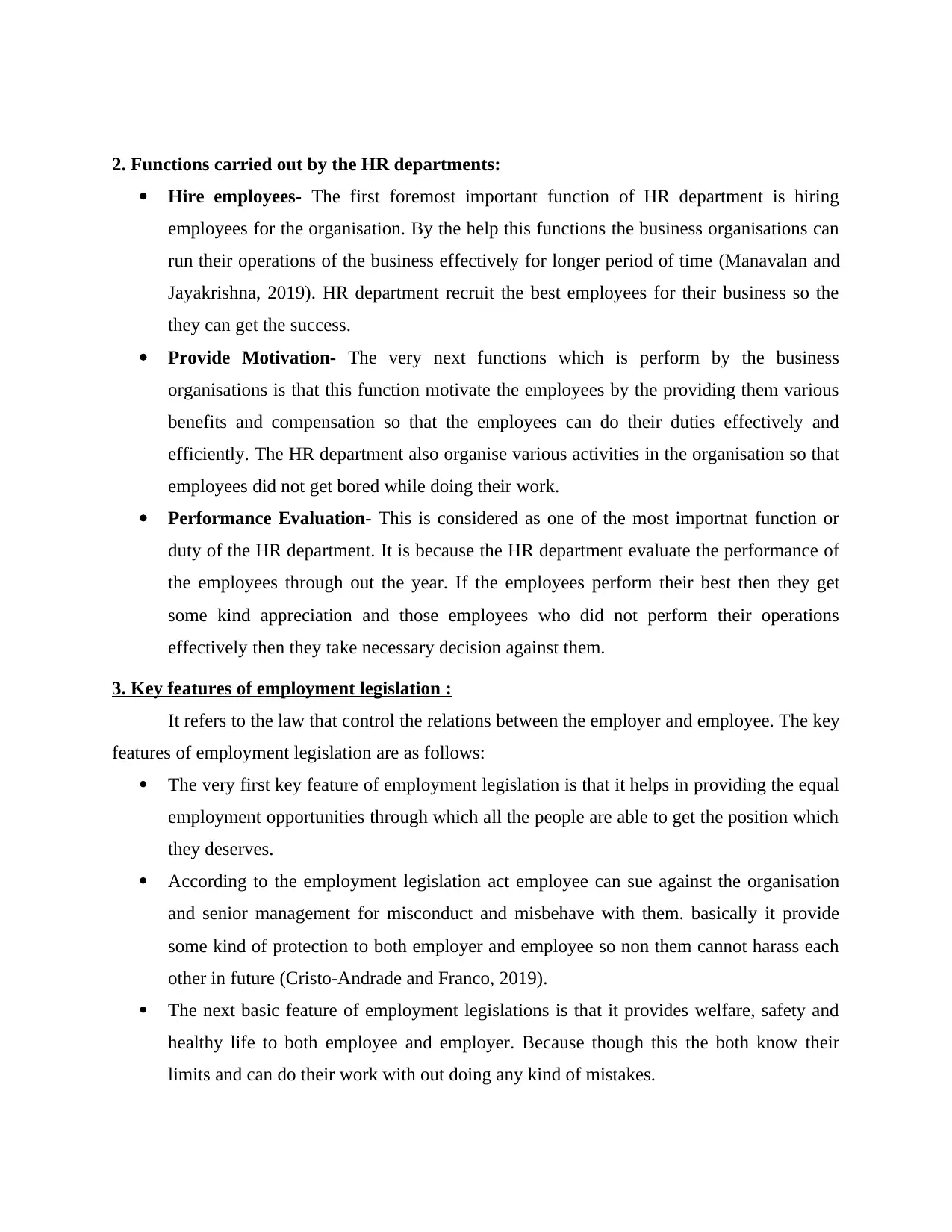
2. Functions carried out by the HR departments:
Hire employees- The first foremost important function of HR department is hiring
employees for the organisation. By the help this functions the business organisations can
run their operations of the business effectively for longer period of time (Manavalan and
Jayakrishna, 2019). HR department recruit the best employees for their business so the
they can get the success.
Provide Motivation- The very next functions which is perform by the business
organisations is that this function motivate the employees by the providing them various
benefits and compensation so that the employees can do their duties effectively and
efficiently. The HR department also organise various activities in the organisation so that
employees did not get bored while doing their work.
Performance Evaluation- This is considered as one of the most importnat function or
duty of the HR department. It is because the HR department evaluate the performance of
the employees through out the year. If the employees perform their best then they get
some kind appreciation and those employees who did not perform their operations
effectively then they take necessary decision against them.
3. Key features of employment legislation :
It refers to the law that control the relations between the employer and employee. The key
features of employment legislation are as follows:
The very first key feature of employment legislation is that it helps in providing the equal
employment opportunities through which all the people are able to get the position which
they deserves.
According to the employment legislation act employee can sue against the organisation
and senior management for misconduct and misbehave with them. basically it provide
some kind of protection to both employer and employee so non them cannot harass each
other in future (Cristo-Andrade and Franco, 2019).
The next basic feature of employment legislations is that it provides welfare, safety and
healthy life to both employee and employer. Because though this the both know their
limits and can do their work with out doing any kind of mistakes.
Hire employees- The first foremost important function of HR department is hiring
employees for the organisation. By the help this functions the business organisations can
run their operations of the business effectively for longer period of time (Manavalan and
Jayakrishna, 2019). HR department recruit the best employees for their business so the
they can get the success.
Provide Motivation- The very next functions which is perform by the business
organisations is that this function motivate the employees by the providing them various
benefits and compensation so that the employees can do their duties effectively and
efficiently. The HR department also organise various activities in the organisation so that
employees did not get bored while doing their work.
Performance Evaluation- This is considered as one of the most importnat function or
duty of the HR department. It is because the HR department evaluate the performance of
the employees through out the year. If the employees perform their best then they get
some kind appreciation and those employees who did not perform their operations
effectively then they take necessary decision against them.
3. Key features of employment legislation :
It refers to the law that control the relations between the employer and employee. The key
features of employment legislation are as follows:
The very first key feature of employment legislation is that it helps in providing the equal
employment opportunities through which all the people are able to get the position which
they deserves.
According to the employment legislation act employee can sue against the organisation
and senior management for misconduct and misbehave with them. basically it provide
some kind of protection to both employer and employee so non them cannot harass each
other in future (Cristo-Andrade and Franco, 2019).
The next basic feature of employment legislations is that it provides welfare, safety and
healthy life to both employee and employer. Because though this the both know their
limits and can do their work with out doing any kind of mistakes.
Paraphrase This Document
Need a fresh take? Get an instant paraphrase of this document with our AI Paraphraser
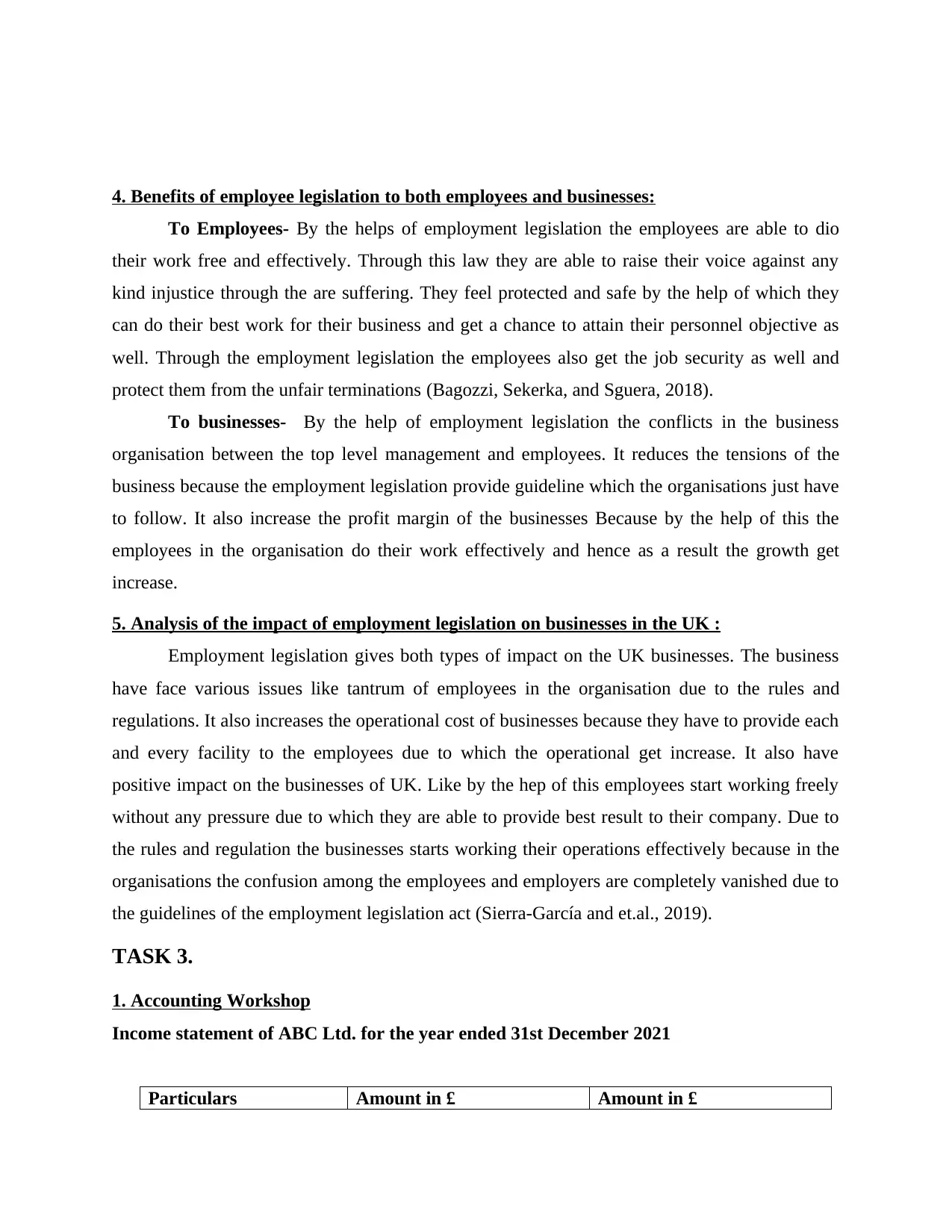
4. Benefits of employee legislation to both employees and businesses:
To Employees- By the helps of employment legislation the employees are able to dio
their work free and effectively. Through this law they are able to raise their voice against any
kind injustice through the are suffering. They feel protected and safe by the help of which they
can do their best work for their business and get a chance to attain their personnel objective as
well. Through the employment legislation the employees also get the job security as well and
protect them from the unfair terminations (Bagozzi, Sekerka, and Sguera, 2018).
To businesses- By the help of employment legislation the conflicts in the business
organisation between the top level management and employees. It reduces the tensions of the
business because the employment legislation provide guideline which the organisations just have
to follow. It also increase the profit margin of the businesses Because by the help of this the
employees in the organisation do their work effectively and hence as a result the growth get
increase.
5. Analysis of the impact of employment legislation on businesses in the UK :
Employment legislation gives both types of impact on the UK businesses. The business
have face various issues like tantrum of employees in the organisation due to the rules and
regulations. It also increases the operational cost of businesses because they have to provide each
and every facility to the employees due to which the operational get increase. It also have
positive impact on the businesses of UK. Like by the hep of this employees start working freely
without any pressure due to which they are able to provide best result to their company. Due to
the rules and regulation the businesses starts working their operations effectively because in the
organisations the confusion among the employees and employers are completely vanished due to
the guidelines of the employment legislation act (Sierra-García and et.al., 2019).
TASK 3.
1. Accounting Workshop
Income statement of ABC Ltd. for the year ended 31st December 2021
Particulars Amount in £ Amount in £
To Employees- By the helps of employment legislation the employees are able to dio
their work free and effectively. Through this law they are able to raise their voice against any
kind injustice through the are suffering. They feel protected and safe by the help of which they
can do their best work for their business and get a chance to attain their personnel objective as
well. Through the employment legislation the employees also get the job security as well and
protect them from the unfair terminations (Bagozzi, Sekerka, and Sguera, 2018).
To businesses- By the help of employment legislation the conflicts in the business
organisation between the top level management and employees. It reduces the tensions of the
business because the employment legislation provide guideline which the organisations just have
to follow. It also increase the profit margin of the businesses Because by the help of this the
employees in the organisation do their work effectively and hence as a result the growth get
increase.
5. Analysis of the impact of employment legislation on businesses in the UK :
Employment legislation gives both types of impact on the UK businesses. The business
have face various issues like tantrum of employees in the organisation due to the rules and
regulations. It also increases the operational cost of businesses because they have to provide each
and every facility to the employees due to which the operational get increase. It also have
positive impact on the businesses of UK. Like by the hep of this employees start working freely
without any pressure due to which they are able to provide best result to their company. Due to
the rules and regulation the businesses starts working their operations effectively because in the
organisations the confusion among the employees and employers are completely vanished due to
the guidelines of the employment legislation act (Sierra-García and et.al., 2019).
TASK 3.
1. Accounting Workshop
Income statement of ABC Ltd. for the year ended 31st December 2021
Particulars Amount in £ Amount in £
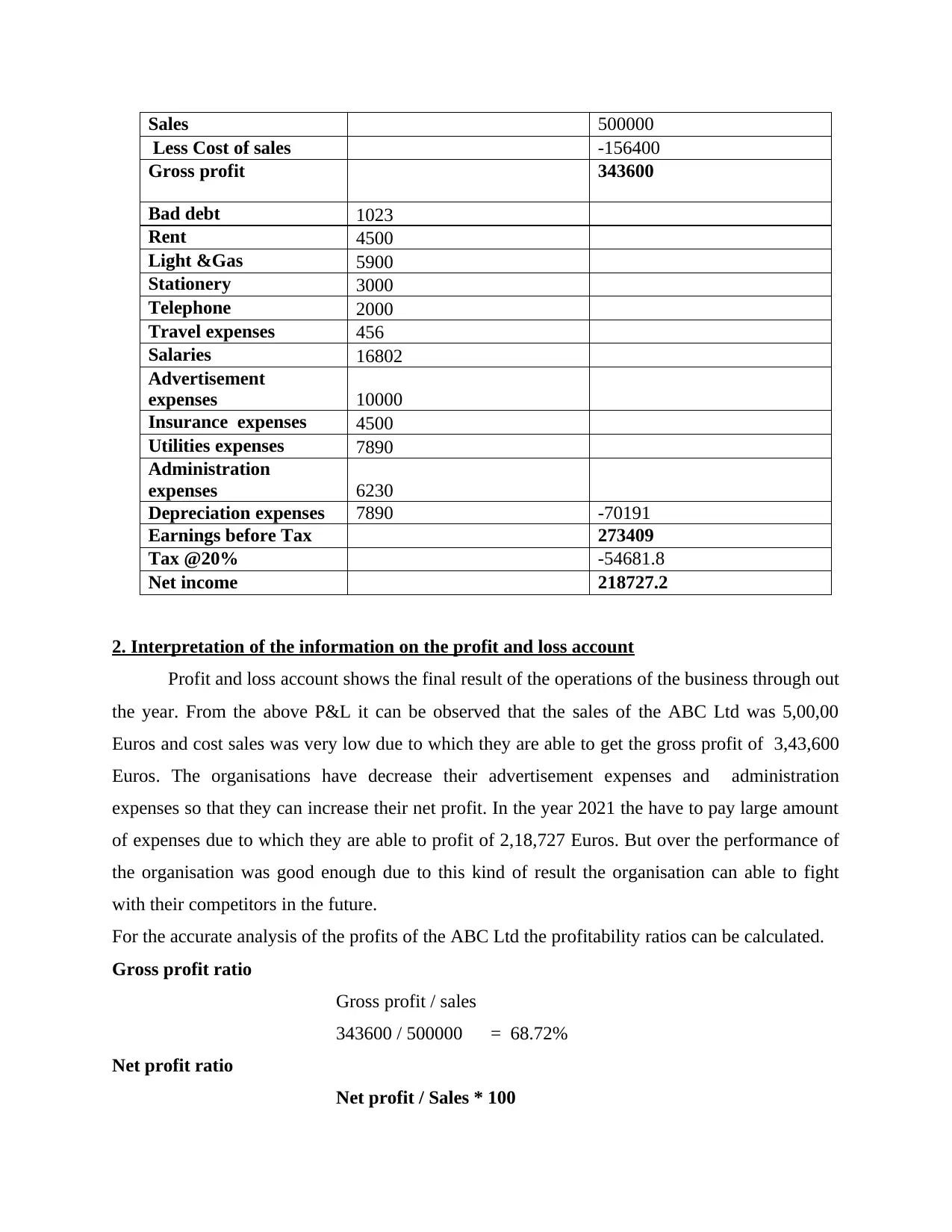
Sales 500000
Less Cost of sales -156400
Gross profit 343600
Bad debt 1023
Rent 4500
Light &Gas 5900
Stationery 3000
Telephone 2000
Travel expenses 456
Salaries 16802
Advertisement
expenses 10000
Insurance expenses 4500
Utilities expenses 7890
Administration
expenses 6230
Depreciation expenses 7890 -70191
Earnings before Tax 273409
Tax @20% -54681.8
Net income 218727.2
2. Interpretation of the information on the profit and loss account
Profit and loss account shows the final result of the operations of the business through out
the year. From the above P&L it can be observed that the sales of the ABC Ltd was 5,00,00
Euros and cost sales was very low due to which they are able to get the gross profit of 3,43,600
Euros. The organisations have decrease their advertisement expenses and administration
expenses so that they can increase their net profit. In the year 2021 the have to pay large amount
of expenses due to which they are able to profit of 2,18,727 Euros. But over the performance of
the organisation was good enough due to this kind of result the organisation can able to fight
with their competitors in the future.
For the accurate analysis of the profits of the ABC Ltd the profitability ratios can be calculated.
Gross profit ratio
Gross profit / sales
343600 / 500000 = 68.72%
Net profit ratio
Net profit / Sales * 100
Less Cost of sales -156400
Gross profit 343600
Bad debt 1023
Rent 4500
Light &Gas 5900
Stationery 3000
Telephone 2000
Travel expenses 456
Salaries 16802
Advertisement
expenses 10000
Insurance expenses 4500
Utilities expenses 7890
Administration
expenses 6230
Depreciation expenses 7890 -70191
Earnings before Tax 273409
Tax @20% -54681.8
Net income 218727.2
2. Interpretation of the information on the profit and loss account
Profit and loss account shows the final result of the operations of the business through out
the year. From the above P&L it can be observed that the sales of the ABC Ltd was 5,00,00
Euros and cost sales was very low due to which they are able to get the gross profit of 3,43,600
Euros. The organisations have decrease their advertisement expenses and administration
expenses so that they can increase their net profit. In the year 2021 the have to pay large amount
of expenses due to which they are able to profit of 2,18,727 Euros. But over the performance of
the organisation was good enough due to this kind of result the organisation can able to fight
with their competitors in the future.
For the accurate analysis of the profits of the ABC Ltd the profitability ratios can be calculated.
Gross profit ratio
Gross profit / sales
343600 / 500000 = 68.72%
Net profit ratio
Net profit / Sales * 100
⊘ This is a preview!⊘
Do you want full access?
Subscribe today to unlock all pages.

Trusted by 1+ million students worldwide
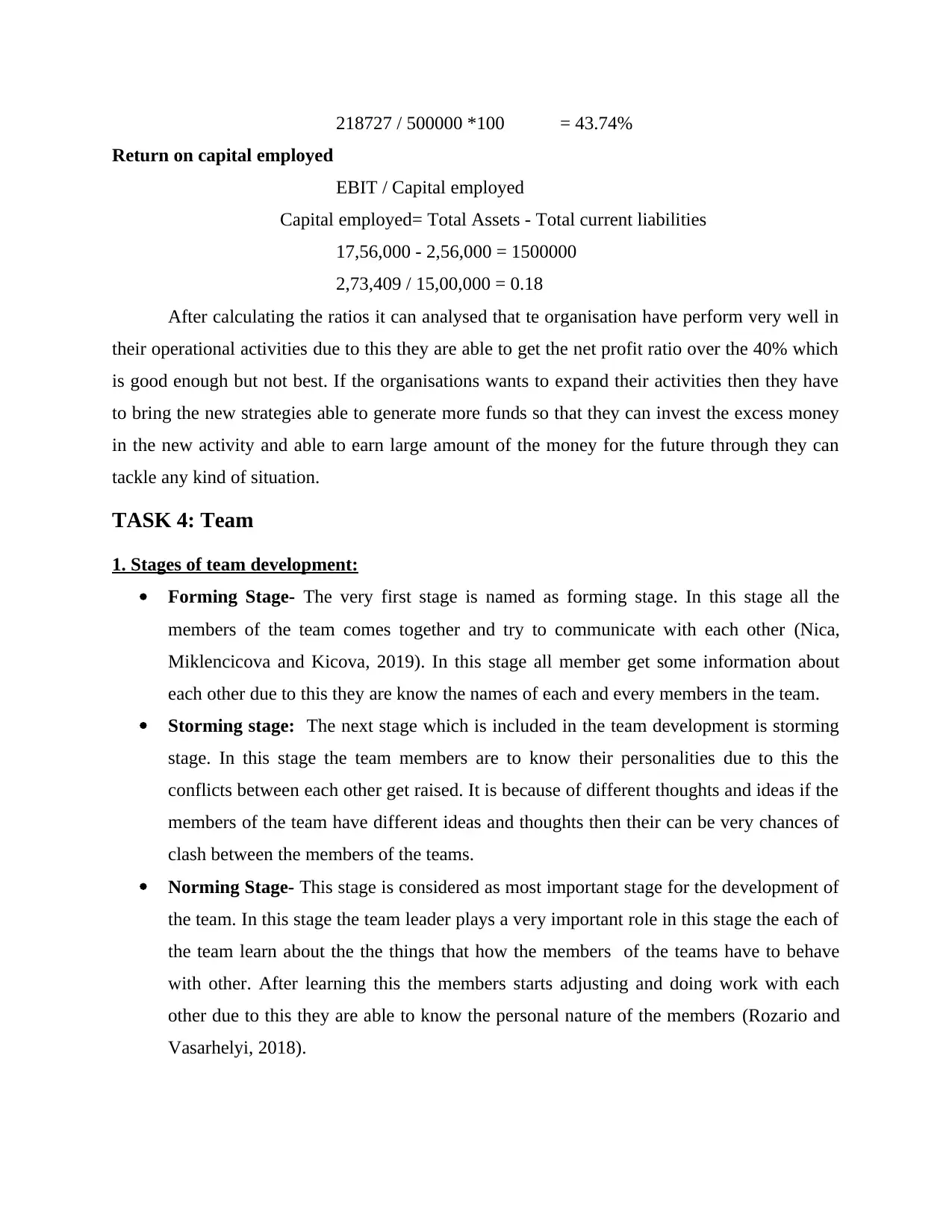
218727 / 500000 *100 = 43.74%
Return on capital employed
EBIT / Capital employed
Capital employed= Total Assets - Total current liabilities
17,56,000 - 2,56,000 = 1500000
2,73,409 / 15,00,000 = 0.18
After calculating the ratios it can analysed that te organisation have perform very well in
their operational activities due to this they are able to get the net profit ratio over the 40% which
is good enough but not best. If the organisations wants to expand their activities then they have
to bring the new strategies able to generate more funds so that they can invest the excess money
in the new activity and able to earn large amount of the money for the future through they can
tackle any kind of situation.
TASK 4: Team
1. Stages of team development:
Forming Stage- The very first stage is named as forming stage. In this stage all the
members of the team comes together and try to communicate with each other (Nica,
Miklencicova and Kicova, 2019). In this stage all member get some information about
each other due to this they are know the names of each and every members in the team.
Storming stage: The next stage which is included in the team development is storming
stage. In this stage the team members are to know their personalities due to this the
conflicts between each other get raised. It is because of different thoughts and ideas if the
members of the team have different ideas and thoughts then their can be very chances of
clash between the members of the teams.
Norming Stage- This stage is considered as most important stage for the development of
the team. In this stage the team leader plays a very important role in this stage the each of
the team learn about the the things that how the members of the teams have to behave
with other. After learning this the members starts adjusting and doing work with each
other due to this they are able to know the personal nature of the members (Rozario and
Vasarhelyi, 2018).
Return on capital employed
EBIT / Capital employed
Capital employed= Total Assets - Total current liabilities
17,56,000 - 2,56,000 = 1500000
2,73,409 / 15,00,000 = 0.18
After calculating the ratios it can analysed that te organisation have perform very well in
their operational activities due to this they are able to get the net profit ratio over the 40% which
is good enough but not best. If the organisations wants to expand their activities then they have
to bring the new strategies able to generate more funds so that they can invest the excess money
in the new activity and able to earn large amount of the money for the future through they can
tackle any kind of situation.
TASK 4: Team
1. Stages of team development:
Forming Stage- The very first stage is named as forming stage. In this stage all the
members of the team comes together and try to communicate with each other (Nica,
Miklencicova and Kicova, 2019). In this stage all member get some information about
each other due to this they are know the names of each and every members in the team.
Storming stage: The next stage which is included in the team development is storming
stage. In this stage the team members are to know their personalities due to this the
conflicts between each other get raised. It is because of different thoughts and ideas if the
members of the team have different ideas and thoughts then their can be very chances of
clash between the members of the teams.
Norming Stage- This stage is considered as most important stage for the development of
the team. In this stage the team leader plays a very important role in this stage the each of
the team learn about the the things that how the members of the teams have to behave
with other. After learning this the members starts adjusting and doing work with each
other due to this they are able to know the personal nature of the members (Rozario and
Vasarhelyi, 2018).
Paraphrase This Document
Need a fresh take? Get an instant paraphrase of this document with our AI Paraphraser
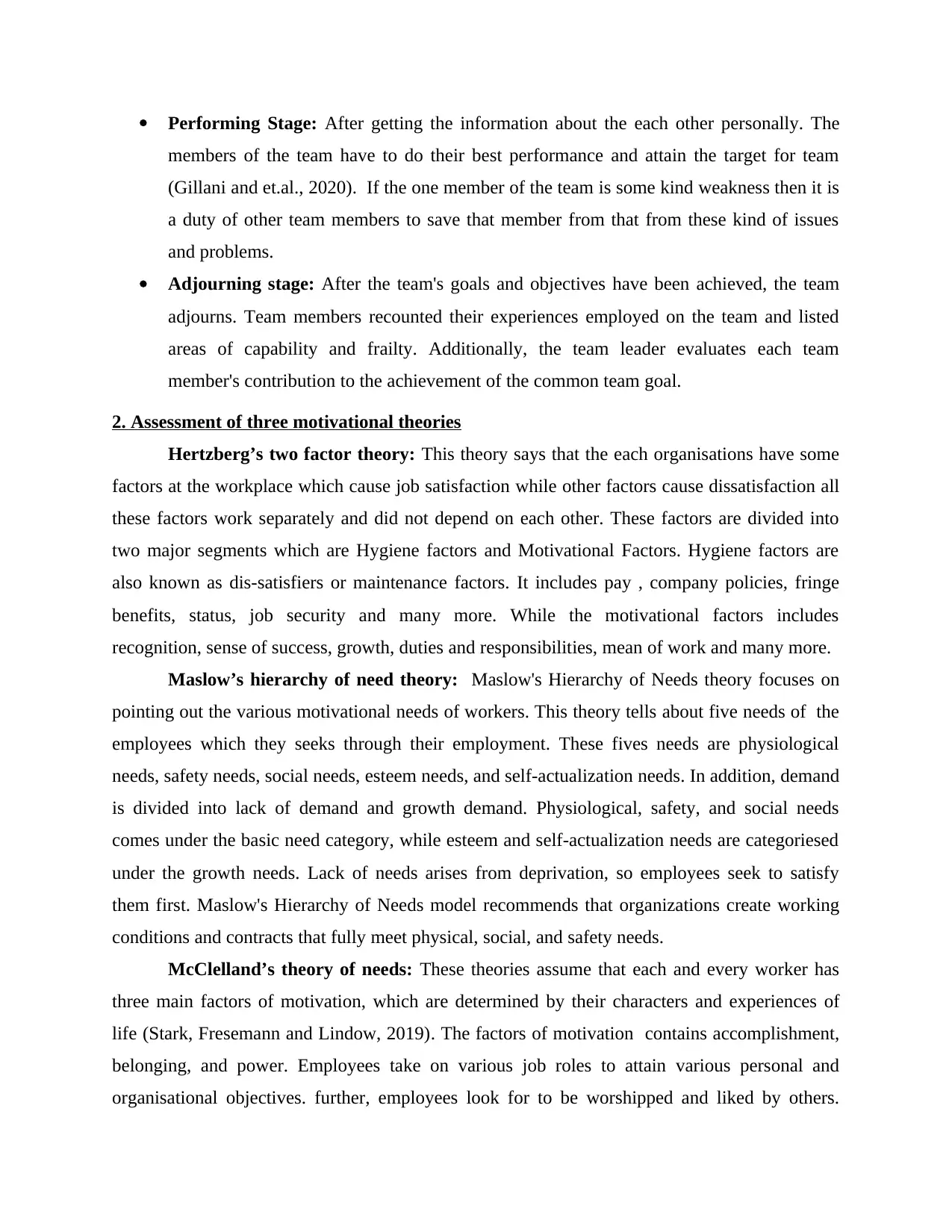
Performing Stage: After getting the information about the each other personally. The
members of the team have to do their best performance and attain the target for team
(Gillani and et.al., 2020). If the one member of the team is some kind weakness then it is
a duty of other team members to save that member from that from these kind of issues
and problems.
Adjourning stage: After the team's goals and objectives have been achieved, the team
adjourns. Team members recounted their experiences employed on the team and listed
areas of capability and frailty. Additionally, the team leader evaluates each team
member's contribution to the achievement of the common team goal.
2. Assessment of three motivational theories
Hertzberg’s two factor theory: This theory says that the each organisations have some
factors at the workplace which cause job satisfaction while other factors cause dissatisfaction all
these factors work separately and did not depend on each other. These factors are divided into
two major segments which are Hygiene factors and Motivational Factors. Hygiene factors are
also known as dis-satisfiers or maintenance factors. It includes pay , company policies, fringe
benefits, status, job security and many more. While the motivational factors includes
recognition, sense of success, growth, duties and responsibilities, mean of work and many more.
Maslow’s hierarchy of need theory: Maslow's Hierarchy of Needs theory focuses on
pointing out the various motivational needs of workers. This theory tells about five needs of the
employees which they seeks through their employment. These fives needs are physiological
needs, safety needs, social needs, esteem needs, and self-actualization needs. In addition, demand
is divided into lack of demand and growth demand. Physiological, safety, and social needs
comes under the basic need category, while esteem and self-actualization needs are categoriesed
under the growth needs. Lack of needs arises from deprivation, so employees seek to satisfy
them first. Maslow's Hierarchy of Needs model recommends that organizations create working
conditions and contracts that fully meet physical, social, and safety needs.
McClelland’s theory of needs: These theories assume that each and every worker has
three main factors of motivation, which are determined by their characters and experiences of
life (Stark, Fresemann and Lindow, 2019). The factors of motivation contains accomplishment,
belonging, and power. Employees take on various job roles to attain various personal and
organisational objectives. further, employees look for to be worshipped and liked by others.
members of the team have to do their best performance and attain the target for team
(Gillani and et.al., 2020). If the one member of the team is some kind weakness then it is
a duty of other team members to save that member from that from these kind of issues
and problems.
Adjourning stage: After the team's goals and objectives have been achieved, the team
adjourns. Team members recounted their experiences employed on the team and listed
areas of capability and frailty. Additionally, the team leader evaluates each team
member's contribution to the achievement of the common team goal.
2. Assessment of three motivational theories
Hertzberg’s two factor theory: This theory says that the each organisations have some
factors at the workplace which cause job satisfaction while other factors cause dissatisfaction all
these factors work separately and did not depend on each other. These factors are divided into
two major segments which are Hygiene factors and Motivational Factors. Hygiene factors are
also known as dis-satisfiers or maintenance factors. It includes pay , company policies, fringe
benefits, status, job security and many more. While the motivational factors includes
recognition, sense of success, growth, duties and responsibilities, mean of work and many more.
Maslow’s hierarchy of need theory: Maslow's Hierarchy of Needs theory focuses on
pointing out the various motivational needs of workers. This theory tells about five needs of the
employees which they seeks through their employment. These fives needs are physiological
needs, safety needs, social needs, esteem needs, and self-actualization needs. In addition, demand
is divided into lack of demand and growth demand. Physiological, safety, and social needs
comes under the basic need category, while esteem and self-actualization needs are categoriesed
under the growth needs. Lack of needs arises from deprivation, so employees seek to satisfy
them first. Maslow's Hierarchy of Needs model recommends that organizations create working
conditions and contracts that fully meet physical, social, and safety needs.
McClelland’s theory of needs: These theories assume that each and every worker has
three main factors of motivation, which are determined by their characters and experiences of
life (Stark, Fresemann and Lindow, 2019). The factors of motivation contains accomplishment,
belonging, and power. Employees take on various job roles to attain various personal and
organisational objectives. further, employees look for to be worshipped and liked by others.
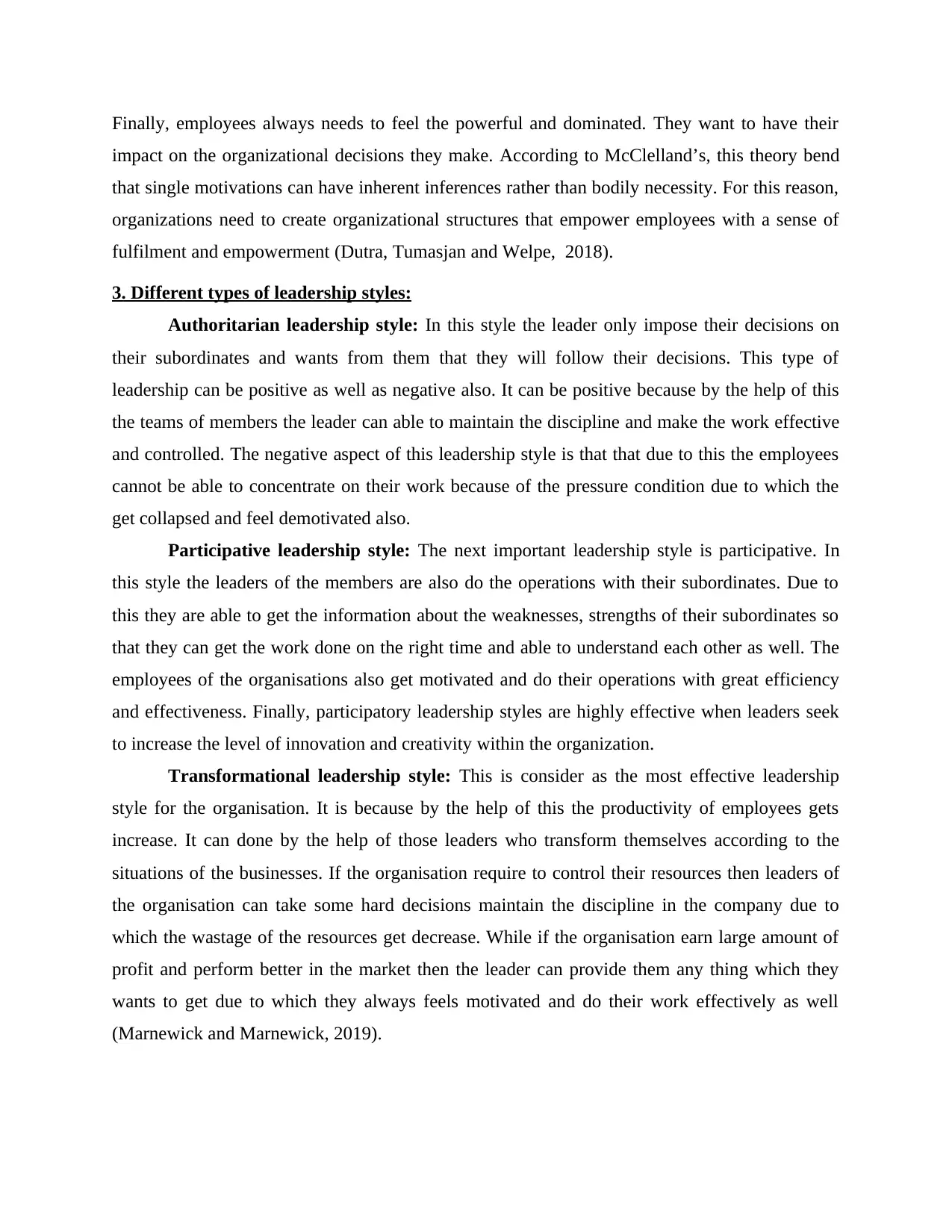
Finally, employees always needs to feel the powerful and dominated. They want to have their
impact on the organizational decisions they make. According to McClelland’s, this theory bend
that single motivations can have inherent inferences rather than bodily necessity. For this reason,
organizations need to create organizational structures that empower employees with a sense of
fulfilment and empowerment (Dutra, Tumasjan and Welpe, 2018).
3. Different types of leadership styles:
Authoritarian leadership style: In this style the leader only impose their decisions on
their subordinates and wants from them that they will follow their decisions. This type of
leadership can be positive as well as negative also. It can be positive because by the help of this
the teams of members the leader can able to maintain the discipline and make the work effective
and controlled. The negative aspect of this leadership style is that that due to this the employees
cannot be able to concentrate on their work because of the pressure condition due to which the
get collapsed and feel demotivated also.
Participative leadership style: The next important leadership style is participative. In
this style the leaders of the members are also do the operations with their subordinates. Due to
this they are able to get the information about the weaknesses, strengths of their subordinates so
that they can get the work done on the right time and able to understand each other as well. The
employees of the organisations also get motivated and do their operations with great efficiency
and effectiveness. Finally, participatory leadership styles are highly effective when leaders seek
to increase the level of innovation and creativity within the organization.
Transformational leadership style: This is consider as the most effective leadership
style for the organisation. It is because by the help of this the productivity of employees gets
increase. It can done by the help of those leaders who transform themselves according to the
situations of the businesses. If the organisation require to control their resources then leaders of
the organisation can take some hard decisions maintain the discipline in the company due to
which the wastage of the resources get decrease. While if the organisation earn large amount of
profit and perform better in the market then the leader can provide them any thing which they
wants to get due to which they always feels motivated and do their work effectively as well
(Marnewick and Marnewick, 2019).
impact on the organizational decisions they make. According to McClelland’s, this theory bend
that single motivations can have inherent inferences rather than bodily necessity. For this reason,
organizations need to create organizational structures that empower employees with a sense of
fulfilment and empowerment (Dutra, Tumasjan and Welpe, 2018).
3. Different types of leadership styles:
Authoritarian leadership style: In this style the leader only impose their decisions on
their subordinates and wants from them that they will follow their decisions. This type of
leadership can be positive as well as negative also. It can be positive because by the help of this
the teams of members the leader can able to maintain the discipline and make the work effective
and controlled. The negative aspect of this leadership style is that that due to this the employees
cannot be able to concentrate on their work because of the pressure condition due to which the
get collapsed and feel demotivated also.
Participative leadership style: The next important leadership style is participative. In
this style the leaders of the members are also do the operations with their subordinates. Due to
this they are able to get the information about the weaknesses, strengths of their subordinates so
that they can get the work done on the right time and able to understand each other as well. The
employees of the organisations also get motivated and do their operations with great efficiency
and effectiveness. Finally, participatory leadership styles are highly effective when leaders seek
to increase the level of innovation and creativity within the organization.
Transformational leadership style: This is consider as the most effective leadership
style for the organisation. It is because by the help of this the productivity of employees gets
increase. It can done by the help of those leaders who transform themselves according to the
situations of the businesses. If the organisation require to control their resources then leaders of
the organisation can take some hard decisions maintain the discipline in the company due to
which the wastage of the resources get decrease. While if the organisation earn large amount of
profit and perform better in the market then the leader can provide them any thing which they
wants to get due to which they always feels motivated and do their work effectively as well
(Marnewick and Marnewick, 2019).
⊘ This is a preview!⊘
Do you want full access?
Subscribe today to unlock all pages.

Trusted by 1+ million students worldwide
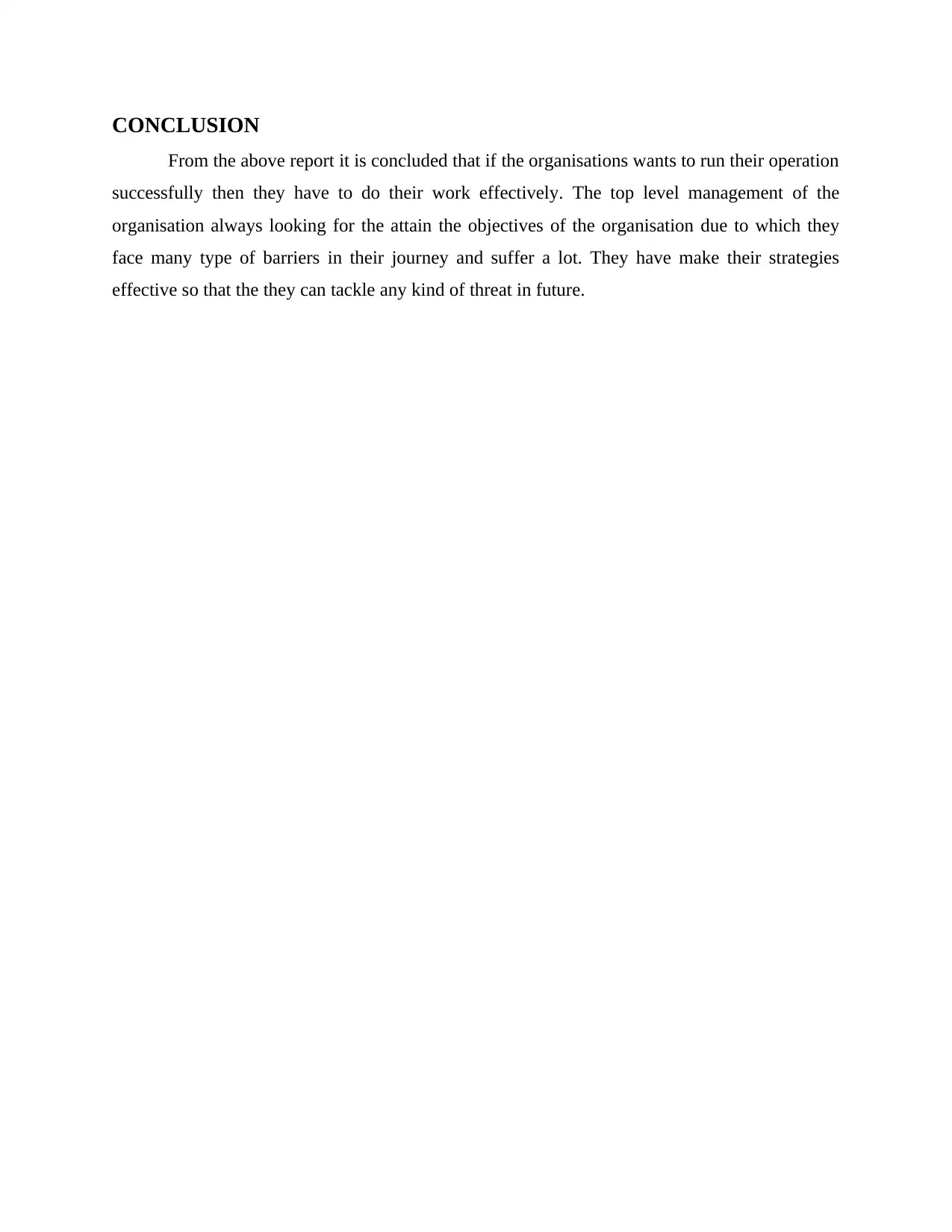
CONCLUSION
From the above report it is concluded that if the organisations wants to run their operation
successfully then they have to do their work effectively. The top level management of the
organisation always looking for the attain the objectives of the organisation due to which they
face many type of barriers in their journey and suffer a lot. They have make their strategies
effective so that the they can tackle any kind of threat in future.
From the above report it is concluded that if the organisations wants to run their operation
successfully then they have to do their work effectively. The top level management of the
organisation always looking for the attain the objectives of the organisation due to which they
face many type of barriers in their journey and suffer a lot. They have make their strategies
effective so that the they can tackle any kind of threat in future.
Paraphrase This Document
Need a fresh take? Get an instant paraphrase of this document with our AI Paraphraser
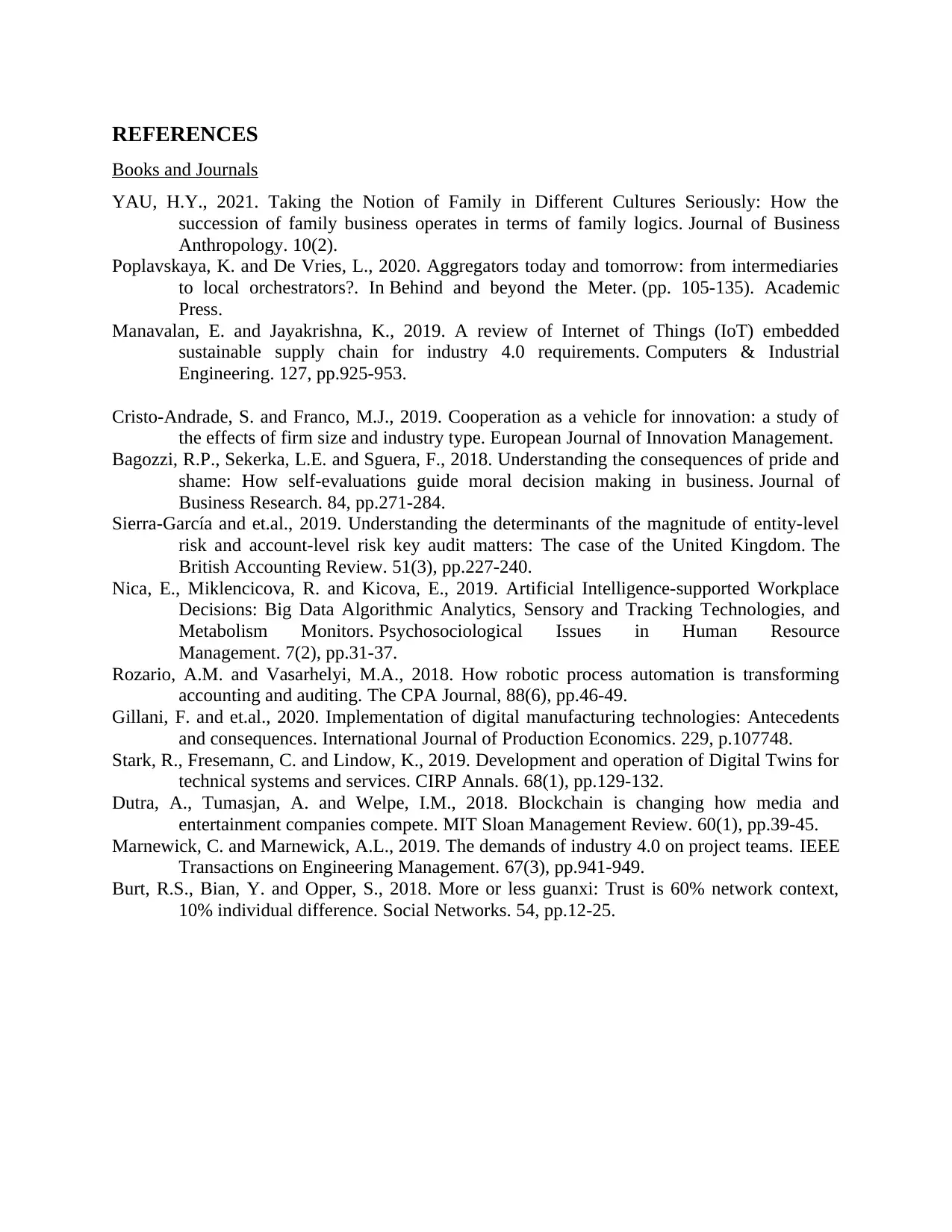
REFERENCES
Books and Journals
YAU, H.Y., 2021. Taking the Notion of Family in Different Cultures Seriously: How the
succession of family business operates in terms of family logics. Journal of Business
Anthropology. 10(2).
Poplavskaya, K. and De Vries, L., 2020. Aggregators today and tomorrow: from intermediaries
to local orchestrators?. In Behind and beyond the Meter. (pp. 105-135). Academic
Press.
Manavalan, E. and Jayakrishna, K., 2019. A review of Internet of Things (IoT) embedded
sustainable supply chain for industry 4.0 requirements. Computers & Industrial
Engineering. 127, pp.925-953.
Cristo-Andrade, S. and Franco, M.J., 2019. Cooperation as a vehicle for innovation: a study of
the effects of firm size and industry type. European Journal of Innovation Management.
Bagozzi, R.P., Sekerka, L.E. and Sguera, F., 2018. Understanding the consequences of pride and
shame: How self-evaluations guide moral decision making in business. Journal of
Business Research. 84, pp.271-284.
Sierra-García and et.al., 2019. Understanding the determinants of the magnitude of entity-level
risk and account-level risk key audit matters: The case of the United Kingdom. The
British Accounting Review. 51(3), pp.227-240.
Nica, E., Miklencicova, R. and Kicova, E., 2019. Artificial Intelligence-supported Workplace
Decisions: Big Data Algorithmic Analytics, Sensory and Tracking Technologies, and
Metabolism Monitors. Psychosociological Issues in Human Resource
Management. 7(2), pp.31-37.
Rozario, A.M. and Vasarhelyi, M.A., 2018. How robotic process automation is transforming
accounting and auditing. The CPA Journal, 88(6), pp.46-49.
Gillani, F. and et.al., 2020. Implementation of digital manufacturing technologies: Antecedents
and consequences. International Journal of Production Economics. 229, p.107748.
Stark, R., Fresemann, C. and Lindow, K., 2019. Development and operation of Digital Twins for
technical systems and services. CIRP Annals. 68(1), pp.129-132.
Dutra, A., Tumasjan, A. and Welpe, I.M., 2018. Blockchain is changing how media and
entertainment companies compete. MIT Sloan Management Review. 60(1), pp.39-45.
Marnewick, C. and Marnewick, A.L., 2019. The demands of industry 4.0 on project teams. IEEE
Transactions on Engineering Management. 67(3), pp.941-949.
Burt, R.S., Bian, Y. and Opper, S., 2018. More or less guanxi: Trust is 60% network context,
10% individual difference. Social Networks. 54, pp.12-25.
Books and Journals
YAU, H.Y., 2021. Taking the Notion of Family in Different Cultures Seriously: How the
succession of family business operates in terms of family logics. Journal of Business
Anthropology. 10(2).
Poplavskaya, K. and De Vries, L., 2020. Aggregators today and tomorrow: from intermediaries
to local orchestrators?. In Behind and beyond the Meter. (pp. 105-135). Academic
Press.
Manavalan, E. and Jayakrishna, K., 2019. A review of Internet of Things (IoT) embedded
sustainable supply chain for industry 4.0 requirements. Computers & Industrial
Engineering. 127, pp.925-953.
Cristo-Andrade, S. and Franco, M.J., 2019. Cooperation as a vehicle for innovation: a study of
the effects of firm size and industry type. European Journal of Innovation Management.
Bagozzi, R.P., Sekerka, L.E. and Sguera, F., 2018. Understanding the consequences of pride and
shame: How self-evaluations guide moral decision making in business. Journal of
Business Research. 84, pp.271-284.
Sierra-García and et.al., 2019. Understanding the determinants of the magnitude of entity-level
risk and account-level risk key audit matters: The case of the United Kingdom. The
British Accounting Review. 51(3), pp.227-240.
Nica, E., Miklencicova, R. and Kicova, E., 2019. Artificial Intelligence-supported Workplace
Decisions: Big Data Algorithmic Analytics, Sensory and Tracking Technologies, and
Metabolism Monitors. Psychosociological Issues in Human Resource
Management. 7(2), pp.31-37.
Rozario, A.M. and Vasarhelyi, M.A., 2018. How robotic process automation is transforming
accounting and auditing. The CPA Journal, 88(6), pp.46-49.
Gillani, F. and et.al., 2020. Implementation of digital manufacturing technologies: Antecedents
and consequences. International Journal of Production Economics. 229, p.107748.
Stark, R., Fresemann, C. and Lindow, K., 2019. Development and operation of Digital Twins for
technical systems and services. CIRP Annals. 68(1), pp.129-132.
Dutra, A., Tumasjan, A. and Welpe, I.M., 2018. Blockchain is changing how media and
entertainment companies compete. MIT Sloan Management Review. 60(1), pp.39-45.
Marnewick, C. and Marnewick, A.L., 2019. The demands of industry 4.0 on project teams. IEEE
Transactions on Engineering Management. 67(3), pp.941-949.
Burt, R.S., Bian, Y. and Opper, S., 2018. More or less guanxi: Trust is 60% network context,
10% individual difference. Social Networks. 54, pp.12-25.
1 out of 11
Related Documents
Your All-in-One AI-Powered Toolkit for Academic Success.
+13062052269
info@desklib.com
Available 24*7 on WhatsApp / Email
![[object Object]](/_next/static/media/star-bottom.7253800d.svg)
Unlock your academic potential
Copyright © 2020–2025 A2Z Services. All Rights Reserved. Developed and managed by ZUCOL.





